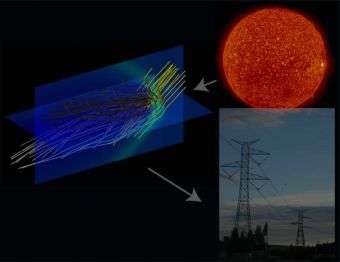Solar Shield Experiment Aims to Keep the Power On

When you flip a light switch to illuminate the pages of your favorite book or reach into your refrigerator for that last piece of key lime pie, you expect the electric current coursing through the outlets to power everything from your lights to your nifty new big-screen television. When the power goes out, it can be more than just an inconvenience.
NASA’s Solar Shield experiment explores how timely space weather forecasts can help power companies keep the power flowing to the many appliances and electronic gadgets we rely on every day.
We consume electricity at an ever-increasing pace. As power companies try to keep up with the demand, they operate ever closer to the limit of their capabilities, leaving little margin for error. Just as these companies rely on advanced warning of severe weather that could disrupt the North American power grid, they also may soon come to rely on near real-time forecasts of severe space weather.
Space weather originates on the sun. Solar eruptions such as solar flares or coronal mass ejections (CMEs) can spew billions of tons of electrically charged particles toward Earth on the solar wind. When this space storm of particles interacts with Earth’s magnetosphere and upper atmosphere, the particles release their energy and sometimes cause a geomagnetically induced current (GIC). GICs are currents flowing in power transmission lines generated by geomagnetic space storms.
Like an unexpected surge of power that overloads your computer if not properly protected, GICs can saturate high-voltage power transformers, causing damage or electric blackouts on a much larger scale. Such an event happened in March 1989, when a space storm took out Canada’s Hydro-Quebec power grid for more than nine hours and resulted in significant economic losses.
The experimental Solar Shield system forecasts what effects earthbound space weather is likely to have on the North American power grid.
“The Solar Shield experiment explores providing advance warning of severe space weather to North American power utility companies in a way that is tailored to their specific needs and locations,” says Dr. Antti Pulkkinen, an assistant research scientist at the University of Maryland Baltimore County’s Earth Science and Technology Center, which is operated at NASA’s Goddard Space Center in Greenbelt, Md.
The researchers use data from observations of the sun and solar wind to estimate the probability of GICs impacting individual power grid nodes, or stations. Observations of CMEs from the Solar and Heliospheric Observatory (SOHO) – a joint NASA/ESA mission – and observations of the solar wind from NASA’s Advanced Composition Explorer (ACE) spacecraft drive computer models that generate a space weather forecast.
“Using observations of the sun and solar wind to drive our space physics models, we generate advanced warning of space weather that can affect high-voltage power transmissions,” says Pulkkinen.
Dr. Pulkkinen and his team utilize computer models at the Community Coordinated Modeling Center (CCMC) at NASA’s Goddard Space Flight Center in Greenbelt, Md., to provide two types of space weather forecasts. Long-term (1-2 days) forecasts use SOHO data and take a few hours to generate. Short-term forecasts (30-60 minutes) use solar-wind observations from ACE and can be generated in a mere 10-15 minutes.
The CCMC, which hosts various models provided by the space physics community, tests and evaluates models and supports space weather forecasters as the models transition into operation. The Solar Shield experiment, now undergoing such testing and evaluation, may be transitioned into actual space weather operations by non-NASA entities in the near future.
The Solar Shield project is a collaborative effort between NASA and the Electric Power Research Institute.
Source: by Laura Layton, NASA’s Goddard Space Flight Center





















